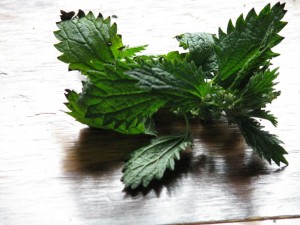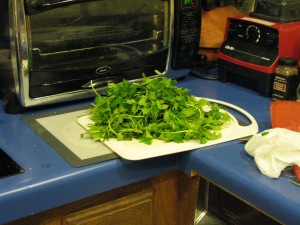-
Cooking with Nettles

Stinging Nettle Yes, I mean stinging nettles. I’ve already covered in another post about the highly nutritious qualities of this lawn and wetlands weed. One of my friends has taken up the cause and has prepared nettles in soup and as a cooked green for her family. Eat your weeds! (Just be sure what they are, first.)
Stinging nettles (Urtica dioica) are annual plants that come up in nitrogen-rich soil that is well watered, such as in lawns, around farm animals and by streams. The plants are covered with tiny sharp hairs that are tipped with chemicals that cause a stinging sensation when handled. The sting may cause a slight bump on the skin and will go away on its own without spreading. A dab of vinegar will de-acidify the affected parts and should reduce or eliminate the sting. The effect is not like that of poison oak (Toxicodendron diversilobum) which contains an oil that spreads to whatever touches it.

This amount of nettles cooks down to 1/4 – 1/2 cup. You’ll need a lot more for this recipe. Nettles are known throughout Europe as a spring green and there are many recipes available for cooking it. The leaves are delicate and fresh-tasting, and the stems a little tougher but also edible.

Crustless nettle quiche tartlet To harvest nettles, wear gloves or use a plastic bag turned inside-out over your hand for protection. As with most greens the youngest are the most tender. Wash the nettles while wearing rubber gloves. Blanch the nettles 1 – 2 minutes in a pot of boiling water. That eliminates the stinging chemicals completely. Don’t cook longer at this point because the leaves will fall apart. You can now eat the nettles or use them in another dish. I’d advise chopping up the stems before or after blanching because they can be stringy. Use blanched nettles in soups, quiches, or fillings as you would spinach. Hint: don’t tell your family what they’re eating until after they’ve eaten it!
Crustless Nettle QuicheAuthor: Diane KennedyRecipe type: Main dish, side dish or breakfastCuisine: EuropeanPrep time:Cook time:Total time:Serves: 6Substitute blanched nettles for spinach in this simple crustless quiche for more nutrition and fewer weeds!Ingredients- 1 Tablespoon olive oil
- 1 chopped onion
- 10 ounces blanched chopped nettles (measured after cooking)
- 5 eggs, beaten
- 3 cups grated cheese such as Munster, or a mixture of parmesan and mozzerella, or whatever you have that isn't too tangy.
- A pinch of ground nutmeg
- Salt and pepper to taste
- Optional: cooked vegetarian bacon or sausage, crumbled.
Instructions- Preheat oven to 350 degrees F.
- Lightly grease one 9-inch pie pan or 6 - 8 tart tins or Pyrex custard cups.
- Wearing gloves, harvest and wash enough nettles to make 10 ounces cooked, about one stuffed plastic grocery bag full or more.
- Blanch nettles in boiling water for 1 -2 minutes.
- Chop nettles into fine pieces (the stems can be stringy if kept long)
- Heat olive oil in a medium skillet over medium-high heat.
- Cook onion until translucent, 8 - 10 minutes
- Add nettles and stir until the extra water is absorbed.
- Add ground nutmeg to the nettles.
- In a large bowl combine the beaten eggs, cheese, salt and pepper and vegetarian meat if using.
- Add spinach mixture to eggs and stir to combine.
- Pour into prepared pan or pans.
- Bake 30 minutes or until centers have just set. Don't over bake.
- Cool for ten minutes before serving.
-
Evil Johnson Grass

Tall seed tassels I found a weed I loathe even more than Bermuda grass. I know that’s hard to believe. Bermuda grass has chased me out of my vegetable garden, and was part of the reason I laboriously built raised beds. It is even now working its way through some of my new planter beds and needs annihilation. I’ve seen Bermuda grass emerge from the top of a five foot hollow metal pole and cascade over the top. It survives under mulch, under rocks, under pavement. Think that is impressive? That’s nothing. Johnson grass has it beat.
I thought that the tall grass growing under the bird feeders was from the bird seed. I let it grow to see what seeds would come from it. The plant looked like corn stalks, and had a little tassel at the top. Pretty innocuous, huh? Then I started looking up on Google images what all the bird seed ingredients looked like in plant form. This stuff didn’t match any of it. Uh-oh. Then I started looking up invasive grasses. Bingo.

Looks like corn, or other weeds. Evil! I read blogs where ranchers complain of having it on their land, and the general response is to burn, salt and run away from the land. Trying to be organic, I sprayed the tops of my Johnson grass with pure white vinegar, then covered them with black plastic during one of our hottest weeks. When I pulled it off the stalks were slightly pale, but boy they were angry. So I took a day and started digging them up and found tremendously thick roots that spread everywhere with such force that one had burrowed up into a log and I had to use a screwdriver to dig it out.
Johnson grass is the ultimate monster, it spreads by seed, by rhizome, and by any microscopic piece of the root left anywhere near the soil.

Roots worming through and around the wire Last winter my daughter and I had built a new heirloom bulb bed, lined with black landscape fabric to deflect weeds, and on top of that aviary wire to deflect the gophers, mice and moles. Guess what emerged? The other day I spent a morning carefully digging out all the Johnson grass in and around the bed, following the roots and unwinding them from the wire which they embraced, while trying not to kill my bulbs. I thought I had won, but only two mornings later, there stood a four-inch tall sprout of Johnson grass! Aaaarrgghhh! So I dug it out, and dug more out, and more and more. Today I decided that I had to start from scratch, so I dug out all the bulbs and scratched out the soil (which I’m afraid to reuse because I know there will some miniscule rhizome just waiting. I think I’ll have to spread the soil out and cook it in the summer sun for a few years or so, just to make sure), and was glad I did. This was a task I was so eager to do in the hot sun while other chores stacked up, too! Not only was the JG entwined with the aviary wire, but it had solid, rooted rhizomes as fat as my thumb wriggling around under the black landscape fabric, consequently under five inches of soil, too.

Thick rhizomes under the landscape fabric I’d use dynamite, but the weed would take advantage and all those bits would come up everywhere. An evil Sourcerer’s Apprentice.

Yes, that is a root sticking through the turned-over aviary wire My fight against Johnson grass will apparently go on for some time. It is coming up in my pot filled with Christmas cactus, and in the midst of a thorny rose bush, and many other places, disguising itself as other weeds. I’ll not only have to keep digging it out, but cutting the stalks of the plants I can’t dig out without destroying a valued garden member. The question comes to mind: if I set Johnson grass against Bermuda grass, which would win? Whichever does win, it deserves burning and salting!